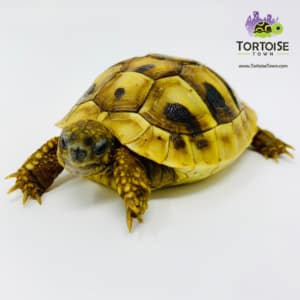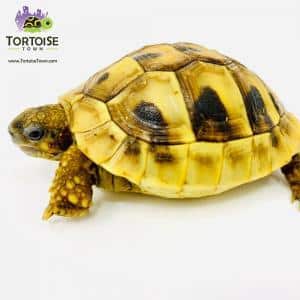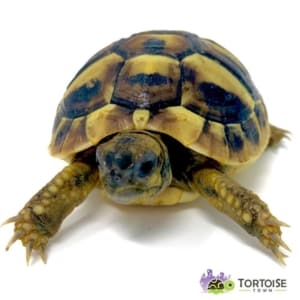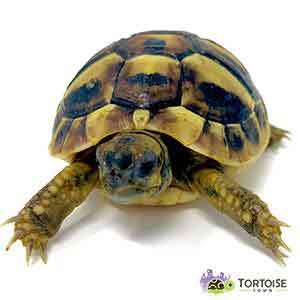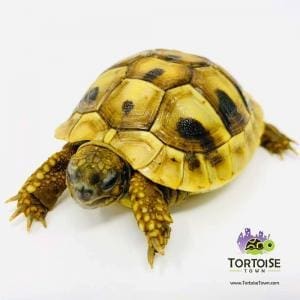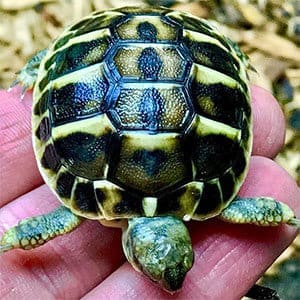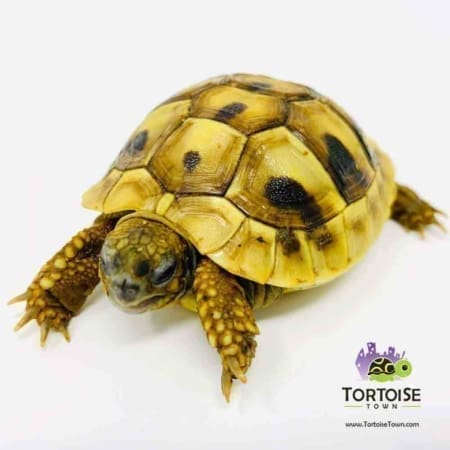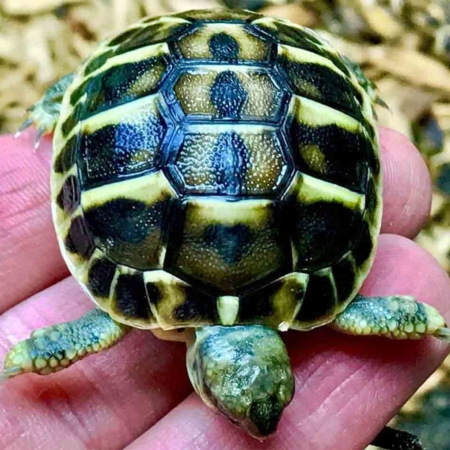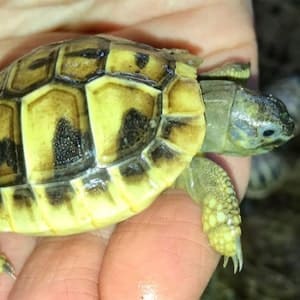Hermann’s tortoise color
Skin color is usually dark and may be tan, brown or grey. The plastron exhibits discontinuous black markings which appear faded, broken up and nowhere near as well defined or prominent as in their western cousins. However, an almost entirely black plastron is sometimes found in specimens deriving from southern Greece. The suture between the pectoral scutes is usually longer than that of the femoral. ALso, or they may be an even length in various cases.
Females typically reach seven to eight inches but extremely large, ten inch plus females have been encountered in parts of the world such as Bulgaria and also in captive collections. Males usually do not surpass seven inches but larger animals are not unheard of. These tortoises have a flatter, broader look and are more elongate than round.
Dalmatian hermann’s tortoise for sale
A third, once accepted subspecies known as “The Dalmatian tortoise (Testudo hermanni hercegovinensis)” is still recognized by many keepers worldwide today. Recently, this tortoise has been discounted by taxonomists as a valid subspecies due to the lack of supporting evidence. Because they are in fact much different from Testudo hermanni boettgeri. Instead, they are considered to be nothing more than a geographical variant of the eastern subspecies.
These animals are rather smallish. They resemble Testudo hermanni hermanni with regards to their size and may even be considered smaller. This is due to the wide array of dimensions found within T. h. hermanni depending on the region they are found. Lastly, females of this variant of Hermann’s tortoise will rarely exceed 6” with males sometimes falling short of 5.5” in Sardinia and Corsica. In Contrast, tortoises belonging to the western subspecies can easily surpass 8”. That being said, you can see how the Dalmatian may at times be considered the smallest members.
Hermann’s tortoise color differences
For decades, tortoise enthusiasts were unaware of this potential third type of Hermann’s tortoise. Unfortunately, this lead to the inevitable cross-breeding of them with pure eastern specimens. The Dalmatian tortoise does exhibit some external differences that certainly set it apart from the western subspecies. Also, these colors differentiate it from the eastern to a degree.Hermann’s Tortoise colors
The colors and markings of the Dalmatian are quite close to that of T. h. boettgeri but may be more defined. Also, the plastron pigment can sometimes depict that of the stripes found on T. h. hermanni but instead are discontinuous. The ratio between the pectoral scute suture and femoral scute suture is often even but may resemble. Most noteworthy, the ratio found in either the western or eastern subspecies.
The suture of the humeral scutes typically forms a sharp, downward curving “U”. However, this may not always be the case and this is also found in a majority of western and eastern tortoises. The head is rather rounded and blunt with a subocluar spot. In addition, the head is usually lacking except in younger specimens. Usually, yellow-green markings are found on the top of the head at the back. The supradcaudal shield may or may not be divided and inguinal scutes. Interesting, these are lacking some 60% of the time. Some specimens will feature only one inguinal scute on either the right or left side.
Many locales of western Hermann’s tortoise for sale
This is where differentiation can become difficult because although very rare, both T. h. boettgeri and T. h. hermanni have been encountered with inguinal scutes lacking entirely. In fact, on Sicily, western tortoises may be lacking only one. This is a trait that is less often seen in other western locales and combined with characteristics. Some of these include the presence of thigh tubercles. (like those found on Testudo graeca) The discovery and addition of a new subspecies of Hermann’s tortoise may surface in years to come. A fourth subspecies has already been proposed but has since failed to gain any real acceptance.
Small eastern tortoises found in the Peloponnesus (southern Greece) have been labeled “Testudo hermanni pelponnesica”. Because they have not graduated from just a geographical variant yet. A complete revision of the taxonomy concerning the Testudo hermanni species group is needed. Because at present, only two subspecies are valid and this raises great concerns for the captive breeding. Also, providing the head-starting of juveniles into nature. Hermann’s tortoises vary quite heavily from region to region and even within a select population. It is imperative that we gain a better understanding of not only the morphological differences. It is these differences that set them apart but also behavioral and perhaps even bio-geomorphology specifics as well.
